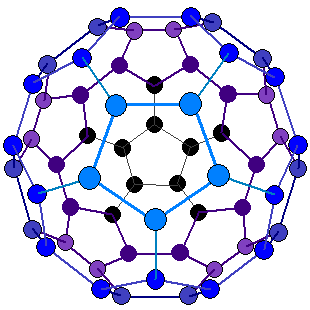What is Buckminsterfullerene?
In 1985 a new allotrope of carbon (C60) was discovered.
Sixty carbon
atoms form the shape of a
ball like a football
with a
carbon atom at each corner
of the 20
hexagons and 12
pentagons.
Each carbon atom (shown below as a
circle) has three bonds.
The size of the molecule is almost
exactly 1nm in
diameter.
The ratio of the size of an
ordinary soccer ball
to the planet
Earth
is the same as
the ratio of the size of a C60 molecule to a soccer
ball.
These are not called giant molecules
because there are only sixty
atoms.
A large number of these molecules can fit together
to form a transparent yellow
solid called fullerite.
This form of carbon
was named after the American architect
Buckminster Fuller,
who was famous for designing a large geodesic dome
which looked similar (sort of) to the molecular structure of C60.
Many other balls of carbon
called fullerenes,
have since been made, including C70, C76, and C84.
These molecules have become known
as "buckyballs".

